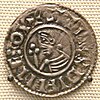Sitric Cáech
In 917, he and his kinsman Ragnall ua Ímair sailed separate fleets to Ireland where they won several battles against local kings.
In 919, Sitric won a victory at the Battle of Islandbridge over a coalition of local Irish kings who aimed to expel the Uí Ímair from Ireland.
Though there are no written accounts of conflict, numismatic evidence suggests there was a Viking reconquest of a large part of Mercia in the following few years.
[5] Archaeological evidence suggests Dublin remained occupied in the years immediately following this expulsion, perhaps indicating only the ruling elite were forced to leave.
[9] According to Downham, "apart from these additions [of saga fragments], Irish chronicles are considered by scholars to be largely accurate records, albeit partisan in their presentation of events".
[12] The Anglo-Saxons conquered all of the Danelaw south of the Humber by 918, but there is no mention of Earl Sitric in English sources, suggesting he was no longer ruling there at the time.
Niall Glúndub, overking of the Northern Uí Néill, saw these Vikings as a threat, and he marched an army south to repel them.
The Vikings fought against the men of the Uí Néill at Mag Femen in County Tipperary and claimed victory, though only through timely reinforcement by Ragnall and his army.
That same year, following his departure from Dublin, Sitric led a raid in Davenport, Cheshire, in violation of the terms of submission agreed between Ragnall and Edward.
[21] Neither the Anglo-Saxon Chronicle nor Æthelweard's Chronicon makes mention of Sitric in the years 921–924, between his installation as King of Northumbria and the death of Edward the Elder.
Downham suggests that the silence of the Chronicle might be due to Edward's failing power in the latter years of his reign, and its tendency to only record successes and not failures.
[33] Orkneyinga saga tells that a daughter of Sitric named Gytha was married to Olaf Tryggvason, King of Norway.
[25] Historians generally describe her as Æthelstan's only full sister, but Maggie Bailey points out that this rests on the late testimony of William of Malmesbury, and the Anglo-Saxon Chronicle makes no such distinction when recording her marriage to Sitric.
[35] William did not know her name, but traditions first recorded at Bury St Edmunds in the early twelfth century identify her as Saint Edith of Polesworth.
[36] According to some late sources, such as the chronicler John of Wallingford, Amlaíb Cuarán was the son of Sitric and this West Saxon princess.


